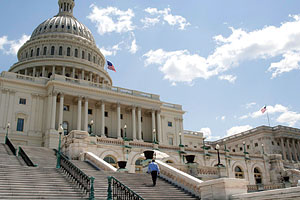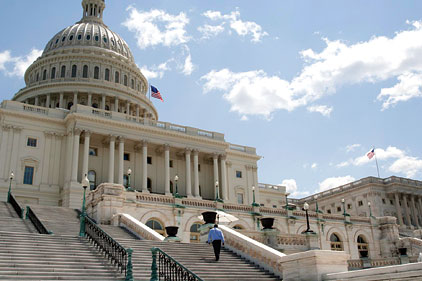The U.S. Department of Energy (DOE) recently published a final rule updating its energy-efficiency standards for new federal buildings from ANSI/ASHRAE/IES Standard 90.1-2007 to ANSI/ASHRAE/IES Standard 90.1-2010. The standard, which will apply to federal buildings for which the design for construction begins on or after July 9, 2014, is expected to save 18.2 percent more energy than the 2007 standard.
While updating to Standard 90.1-2010 will save energy and taxpayer money, it also has the potential to drum up more work for some HVAC contractors — especially those who aren’t afraid to embrace new energy-efficient products and technology.
A Cost-Effective Standard

|
| By updating its energy-efficiency standards for new federal buildings to ANSI/ASHRAE/IES Standard 90.1-2010, the federal government will save an estimated 18.2 percent in energy costs over the 2007 version of the standard. (Photo by Luca Nebuloni) |
Before it could update its energy-efficiency standards to 90.1-2010, the DOE first had to determine whether the standard made sense and if it would save both energy and money in the long run.
“The changes have to be life cycle cost-effective,” ASHRAE president Bill Bahnfleth explained. “They do it by evaluating available technologies to determine how far we can afford to push the equipment’s efficiency, increase insulation in the envelope, improve window performance, and so on. Standard 90.1-2010 raises the bar quite a bit, but does it cost-effectively.”
After analyzing Standard 90.1-2010 for the DOE, the Pacific Northwest National Laboratory determined the standard included numerous positive changes that would further improve energy efficiency, including requiring the use of heat recovery, updating chiller efficiency requirements, reducing ventilation energy, adding efficiency requirements for data centers, expanding automatic damper requirements, and expanding the use of economizers.
Drake Erbe, vice president of market development at AirXchange Inc. and chair of ASHRAE’s Standard 90.1 committee, agreed with Bahnfleth, stating that the standard pushes the envelope on energy efficiency while still making sense financially.
“This is a cost-effective standard that has gone through a rigorous analysis,” he said. “That’s one of the parameters of how we do things in Standard 90.1. It’s fundamental to our methodology — it’s not just something nice to do.”
Bahnfleth said updating to the 2010 version of the standard not only saves energy economically, but also shows how the government and the private sector can work together to achieve a common goal.
“There’s an official determination that 90.1-2010 represents significant progress over 90.1-2007 and establishes a new efficiency floor for federal buildings,” he said. “This ruling is good because it’s increasing the stringency of energy criteria for federal buildings and because it reaffirms the value of the private-public partnership that has produced Standard 90.1.”
Opportunities for Contractors
For the contractors who perform work on federal buildings, or for those who wish to, the transition to Standard 90.1-2010 presents an opportunity.
“The manufacturers and suppliers — they’re all in lock step now,” Erbe said. “They’re providing the equipment that meets the requirements. Now it’s important for the contractor to get this energy savings into the buildings. It’s time to take advantage of it and get it done on the ground, but the only way that’s going to happen is if the contractors actually do it.”
Richard Lord, Carrier fellow and vice chair of ASHRAE’s Standard 90.1 committee, said some contractors who already work on federal buildings may also be affected by the changes.
“They may have to buy a different piece of equipment, and it does impact the cost of some of the work they have to do,” Lord said. He added that the document itself, at more than 120 pages, can be a little overwhelming.
“These contractors will have to get familiar with it, and we have training for that,” he added.
Erbe said the biggest challenge will be for contractors who aren’t already advocating for and installing high-efficiency equipment.
“I think we’re all going in the same basic direction when it comes to energy efficiency, and the contractors who aren’t are the ones who are trying to skirt around the edges,” he said. “It’s going to be much more difficult for those guys. They might as well learn the standards and codes and the right way to do it. They need to get with the program.”
Whereas contractors had a little more freedom to choose which equipment to install in federal buildings before, the new standard will not be as flexible.
“Contractors will not be as free to pick equipment when doing government jobs as they have in the past,” Erbe said. “Standard 90.1-2010 is pretty specific about a number of things.”
The Next Big Thing
While Erbe, Lord, and Bahnfleth all agree the DOE took ample time updating its energy-efficiency standards to Standard 90.1-2010, they said it’s better late than never.
“They’re supposed to do that within one year after Standard 90.1 sets an efficiency level, but often they don’t,” Lord said. “Essentially, they’re a little bit behind.”
Bahnfleth agreed that the DOE is “somewhat behind on that timeline,” though he added, “I think we’re getting our new versions into the federal rules at an acceptable rate.”
ASHRAE is expected to release the next update to the standard, Standard 90.1-2013, sometime in October. How long the DOE will take to evaluate and adopt that standard for federal buildings is unknown, though Lord said the process may be smoother this time around.
“It’s becoming a routine process, so I think when we finish Standard 90.1-2013 later this year, the adoption will likely be quicker,” he said.
Bahnfleth expects it could be several years before 90.1-2013 is adopted for federal buildings. “It will have to go through the evaluation process again,” he said. “That’s just the way things work.”
Meanwhile, Erbe said the federal government’s lead-by-example way of pushing for increased energy efficiency has already made a positive impact on the HVAC industry.
“It’s more important to get the energy savings we already have in code and standards first, to prove that’s happening through the entire chain,” he said. “Certainly, we want them to adopt the latest version, but I’m not sure if the federal government is going to have the same excitement about rushing toward Standard 90.1-2013, only because there was such emphasis from all stakeholders for the 2010 standard.”
Bahnfleth added that while the DOE may be slightly behind, they have been a valuable advocate for energy efficiency.
“We’re very pleased that we continue to have a good partnership with the DOE in the standards area,” Bahnfleth said. “Together, we’re helping to improve the energy picture in the U.S.”
Publication date: 9/30/2013
Want more HVAC industry news and information? Join The NEWS on Facebook, Twitter, and LinkedIn today!



Report Abusive Comment